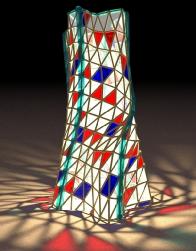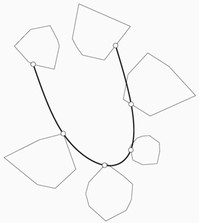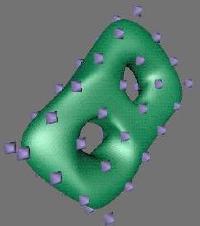Geometric Spline Theory
This web page and the list of publications below
is a snapshot of research done at TU Wien in the years
1993-2005, mostly by Helmut Pottmann and his coauthors.
Speaking of geometric splines means a shift of perspective from
numerical analysis to geometry. The many geometric properties
of well known spline curves become apparent from a
geometric theory at a higher level, which usually reveals more of the
inner structure of the functions or curves or surfaces
already known from other sources.
Another major topic in geometric splines
is the generalization of spline curves to manifolds, domains
with boundary, and similar nonlinear geometries. Geometric
splines are also related to curves defined
by intrinsic subdivision processes.

J. Wallner, M. Hofer, and H. Pottmann.
Fair curve networks in nonlinear geometries
ACM SIGGRAPH 2005 Conference Abstracts and Applications, August 2005.
Fair webs
The Visual Computer 23/1 (2007).
Fair curve networks in nonlinear geometries are
an extension of our work on
energy-minimizing spline curves in manifolds.
Instead of designing with one single curve, we
here present a variational approach for the design with an entire
network of curves. After a geometric characterization of fair,
i.e., energy-minimizing curve networks, we discuss their
discretization and computation. Fair
curve networks in nonlinear geometries have a variety of
applications including surface parameterization, aesthetic
remeshing and design of fair surfaces in the presence of
obstacles.

Wallner, J., Pottmann, H.:
Variational interpolation of subsets.
Constr. Approx. 20 (2004), 233-248.
We consider the problem of variational interpolation of subsets of Euclidean
spaces by curves such that the L2 norm of the second derivative is
minimized. It is well known that the resulting curves are cubic spline curves.
We study geometric boundary conditions arising for various types of subsets
such as subspaces, polyhedra, and submanifolds, and we indicate how solutions can be computed in the case of convex polyhedra.

Wallner, J., Pottmann, H.:
Spline Orbifolds.
In: A. Le Méhauté, C. Rabut, L. Schumaker (Eds.)
Curves and Surfaces with Applications in CAGD,
Vanderbilt University Press, 1997, pp. 445-464.
In order to obtain a global principle for modeling closed surfaces of
arbitrary genus, first hyperbolic geometry and then discrete groups of motions
in planar geometries of constant curvature are studied. The representation of a
closed surface as an orbifold leads to a natural parametrization of the surfaces
as a subset of one of the classical geometries S2, E2,
and H2. This well known connection can be exploited to define spline
function spaces on abstract closed surfaces and use them e.g. for approximation
and interpolation problems.
Publications
-
J. Wallner.
Note on curve and
surface energies.
Comput. Aided Geom. Des 24 (2007), 494-498.
[MR], [doi].
-
M. Hofer, G. Sapiro, and J. Wallner.
Fair polyline
networks for constrained smoothing of digital terrain elevation data.
IEEE Trans. Geosc. Remote Sensing 44/10/2 (2006), 2983-2990.
[doi].
-
J. Wallner, H. Pottmann, and M. Hofer.
Fair curve
networks in nonlinear geometries.
ACM SIGGRAPH 2005 Conference Abstracts and Applications, August 2005
(electronic).
-
J. Wallner, H. Pottmann, and M. Hofer.
Fair webs.
The Visual Computer 23/1 (2007), 83-94.
[doi].
-
M. Hofer and H. Pottmann.
Energy-minimizing
splines in manifolds.
ACM Transactions on Graphics (Proceedings of ACM SIGGRAPH 2004)
23/3 (2004), 284-293.
-
J. Wallner.
Existence of
set-interpolating and energy-minimizing curves.
Comput. Aided Geom. Design 21 (2004), 883-892.
[Zbl], [MR].
-
H. Pottmann, M. Hofer, and B. Ravani.
Variational motion
design.
In J. Lenarčičand C. Galletti, editors, On Advances in Robot
Kinematics, pages 361-370. Kluwer, 2004.
-
H. Pottmann and M. Hofer.
A variational
approach to spline curves on surfaces.
Comput. Aided Geom. Design 22/7 (2005), 693-709.
-
J. Wallner.
Gliding spline
motions and applications.
Comput. Aided Geom. Design 21 (2004), 3-21.
[Zbl], [MR].
-
J. Wallner and H. Pottmann.
Variational
interpolation of subsets.
Constr. Approx. 20 (2004), 233-248.
[Zbl], [MR], [doi].
-
H. Pottmann and S. Leopoldseder.
Geometries for
CAGD.
In G. Farin, J. Hoschek, and M.-S. Kim, editors, Handbook of 3D
Modeling, pages 43-73. Elsevier, 2002.
[MR].
-
S. Leopoldseder.
Algorithms on cone
spline surfaces and spatial sculating arc splines.
Comput. Aided Geom. Design 18 (2001), 505-530.
-
S. Leopoldseder.
Cone spline
surfaces and spatial arc splines - a sphere geometric approach.
Adv. Comput. Math. 17 (2002), 49-66.
-
J. Wallner and H. Pottmann.
Variational
interpolation.
Technical Report 84, Institut für Geometrie, TU Wien, 2001.
-
M. Peternell.
G1-Hermite interpolation of ruled surfaces.
In T. Lyche and L. L. Schumaker, editors, Mathematical Methods in CAGD:
Oslo 2000, Innov. Appl. Math, pages 413-422. Vanderbilt Univ. Press,
Nashville, TN, 2001.
-
H. Pottmann, R. Krasauskas, B. Hamann, K. Joy, and W. Seibold.
On piecewise
linear approximation of quadratic functions.
J. Geom. Graphics 4 (2000), 31-53.
-
H. Pottmann and M. Peternell.
Envelopes -
computational theory and applications.
In B. Falcidieno, editor, Spring Conference on Computer Graphics 2000,
pages 3-23. Comenius University, Bratislava, 2000, ISBN 80-223-1486-2.
Proceedings of the conference in Budmerice, May 3-6, 2000.
-
H. Pottmann and M. Peternell.
On
approximation in spaces of geometric objects.
In R. Cipolla and R. Martin, editors, The Mathematics of Surfaces IX,
pages 438-458. Springer, 2000, ISBN 1852333588.
-
H. Pottmann.
A geometric approach to variation diminishing freeform curve schemes.
In J. M. Peña, editor, Shape preserving representations in
Computer-Aided Design, pages 119-131. Nova Science Publishers, New York,
1999.
-
J. Wallner.
Generalized
multiresolution analysis for arc splines.
In M. Dæhlen, T. Lyche, and L. L. Schumaker, editors, Mathematical
Methods for Curves and Surfaces II, pages 537-544. Vanderbilt University
Press, Nashville, 1998, ISBN 0-8265-1315-8.
[Zbl], [MR].
-
J. Wallner and H. Pottmann.
Spline
orbifolds.
In A. Le Méhauté, C. Rabut, and L. L. Schumaker, editors, Curves
and Surfaces with Applications in CAGD, pages 445-464. Vanderbilt
University Press, 1997.
[Zbl], [MR].
-
J. Wallner and H. Pottmann.
Rational blending
surfaces between quadrics.
Comput. Aided Geom. Design 14 (1997), 407-419.
[MR], [doi].
-
J. Wallner.
Geometric
contributions to surface modeling.
PhD thesis, Technische Universität Wien, 1996.
Advisor: H. Pottmann.
-
M. L. Mazure and H. Pottmann.
Tchebycheff curves.
In M. Gasca and C. A. Micchelli, editors, Total Positivity and Its
Applications, pages 187-218. Kluwer Academic Publishers, Dordrecht, 1995.
-
H. Pottmann.
The geometry of Tchebycheffian splines.
Comp. Aided Geom. Design 10 (1993), 181-210.
|


